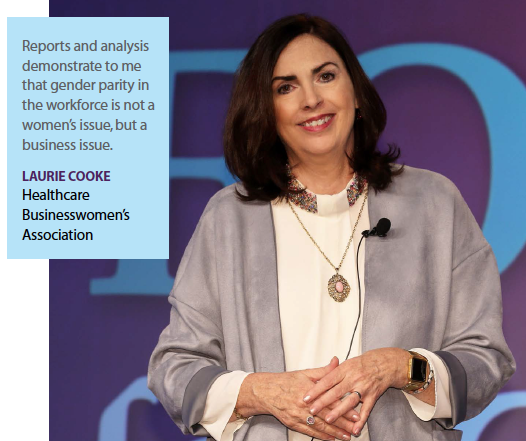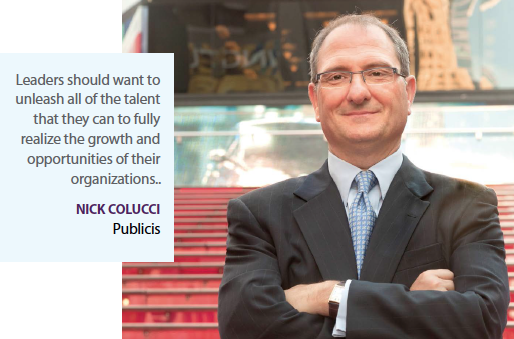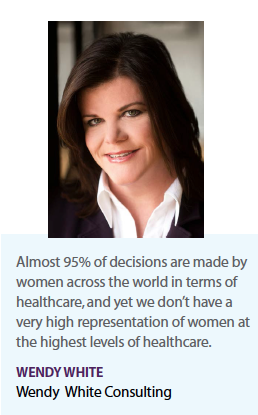A recent McKinsey report reveals that women remain underrepresented at every level in corporate America, despite earning more college degrees than men for 30 years and counting. There is a pressing need to do more, and most organizations realize this: McKinsey reports that company commitment to gender diversity is at an all-time high for the third year in a row.
The case for gender diversity is compelling, but McKinsey research — including a report,  Women Matter 2016: Reinventing the workplace to unlock the potential of gender diversity — shows many companies are still struggling to ensure women are represented fairly in top management. In Western Europe, only 17% of executive-committee members are women, and women comprise just 32% of members of corporate boards for companies listed in Western Europe’s major market indexes. In the United States, the figures are 17% for executive committees and just under 19% for boards.
Women Matter 2016: Reinventing the workplace to unlock the potential of gender diversity — shows many companies are still struggling to ensure women are represented fairly in top management. In Western Europe, only 17% of executive-committee members are women, and women comprise just 32% of members of corporate boards for companies listed in Western Europe’s major market indexes. In the United States, the figures are 17% for executive committees and just under 19% for boards.
At the same time, there is significant research from a 2015 McKinsey Global Institute report that finds advancing women’s equality can add $12 trillion to global growth. This report, which focused on the enormous potential associated with narrowing the gender gap, found that if every country did so at the same historical rate as the fastest-improving country in its regional peer group, the world could add $12 trillion to annual gross domestic product in 2025. That’s 11% higher than it would be under the business-as-usual scenario.
“Gender parity in the workforce is not a women’s issue, but a business issue," says Laurie Cooke, CEO, Healthcare Businesswomen’s Association (HBA). “There are a multitude of benefits for diverse gender representation, but my three top are: improved business performance, better representation and connection with the predominantly female customer, and the future workforce as baby boomers leave the market."
The HBA is addressing the issue of gender parity head on with bold new messaging and an updated brand as well as embedding the goal of leadership equity as part of its mission and  core purpose: achieving gender parity in leadership positions; facilitating career and business connections; and providing effective practices that enable organizations to realize the full potential of their female talent.
core purpose: achieving gender parity in leadership positions; facilitating career and business connections; and providing effective practices that enable organizations to realize the full potential of their female talent.
At the end of 2017, the association launched a new proprietary branded product — the HBA Collaborative — to support organizations to ahcieve their gender parity goals and objectives. The HBA Collaborative is a community of healthcare and life-sciences companies committed to advancing gender parity. Using the right combination of thought leaders and experienced peers, The HBA Collaborative will bring its members practical, measurable solutions for key gender parity opportunities as well as provide industry-wide metrics and benchmarks to enable organizations to see how they measure up against industry peers.
In 2018 and 2019, the HBA Collaborative will support a series of initiatives designed to ignite the use of sponsoring to accelerate advancement of women, leverage the secrets of inclusion, address unconscious bias, empower internal corporate women’s networks, unblock the talent pipeline, and build the executive and C-suite bench. (Editor’s note: visit https://genderparity.hbanet.org/ to learn more about HBA’s gender-parity initiatives.)
“We want to be a united force for change; the HBA is working to not only help business professionals be a catalyst for change for gender parity, we are also supporting our corporate partners in the industry to be the architects of that shift, a shift of true gender parity that supports long-term growth and helps bolster corporate success," Ms. Cooke says.
“A report detailing the power of the purse, notes that women across the world make almost 95% of healthcare decisions, and yet, we don’t have a very high representation of women at the highest levels of healthcare," says Wendy White, founder of Wendy White Consulting and chair of Global Genes. “This just doesn’t make any sense. The more the industry can collaborate through the HBA and other organizations to show the impact that having diversity at every level can make, the better business is going to be and the more opportunities — across the board — everyone will have."
According to Halee Fischer-Wright, M.D., who is president and CEO of the Medical Group Management Association, as a female CEO she lives a kind of “Groundhog Day." She has been quoted as saying: “America’s healthcare industry has a ‘44 long’ problem, meaning there are too many leadership positions filled by men who not only wear the same size jacket, but bring the same perspective — one that adversely impacts the pay and promotion of talented women across the industry.
Michael Rice, founding partner of LifeSci Advisors, agrees that gender diversity makes businesses more successful.
“We’re in a data-driven business and data don’t lie: studies show that companies with greater  gender diversity have better return on equity and better EBIT margins, among other things," he says. “This can’t be just a women’s issue — men are often in the decision-making roles and therefore need to be the ones to foster the structural changes in businesses. Men need to be allies who listen to women, promote women into the C-suite and board roles, and partner with women to make lasting change."
gender diversity have better return on equity and better EBIT margins, among other things," he says. “This can’t be just a women’s issue — men are often in the decision-making roles and therefore need to be the ones to foster the structural changes in businesses. Men need to be allies who listen to women, promote women into the C-suite and board roles, and partner with women to make lasting change."
The issue of gender diversity is not new, but many agree that the time is now to take action.
“We can’t let the pendulum swing back the other way, or go back to ‘normal,’" Mr. Rice says. “The lack of gender diversity is unacceptable and has always been unacceptable, but I think awareness has now been raised, and we as an industry need to continue this momentum and take action. LifeSci Advisors is focusing on putting women on boards of directors, but the industry needs lots of companies to tackle this issue from different angles. Collectively we can make a huge impact."
LifeSci’s Board Placement Initiative helps qualified female executives get placed on boards of directors of life-sciences companies.
“We also support Women In Bio’s Boardroom Ready program, a board certification training course that gives women the background and education they need to serve on a board of directors," he says. “It’s a great way to prepare for board service and network with other women in the industry. We’re constantly on the lookout for great board candidates and open board seats, so we encourage individuals to reach out if they’re interested in board service or know of an open board seat."
Tackling Unconscious Bias
Despite organizations’ commitment to change, McKinsey analysts report that progress continues to be too slow — and may even be stalling. In a study conducted by LeanIn.Org and McKinsey — Women in the Workplace 2017 — with 222 companies employing more than 12 million people, as well as on a survey of more than 70,000 employees and a series of qualitative interviews, data show that one of the biggest reasons for the lack of progress is simple: people have blind spots when it comes to diversity, and we can’t solve problems that we don’t see or understand clearly.
Unconscious biases are social stereotypes about certain groups of people that individuals form outside their own conscious awareness. According to most experts, everyone holds unconscious beliefs about various social and identity groups, and these biases stem from one’s tendency to organize social worlds by categorizing. Unconscious bias is far more prevalent than conscious prejudice and is often incompatible with one’s conscious values. Certain scenarios can activate unconscious attitudes and beliefs. For example, biases may be more prevalent when multi-tasking or working under time pressure.
According to the American Association of University Women (AAUW), research shows that treating women and men equally in hiring decisions, job evaluations, and leadership positions is more of an ideal than a reality. One reason why this continues to be an issue is that many of us harbor unconscious biases that can affect our judgment, even though we may be unaware of them.
Uncovering these unconscious, or implicit, biases can be the first step to eliminating them. In support of this assertion, AAUW provides the following example that shows the pervasive gender associations. Reviewers were asked to evaluate identical résumés belonging to “John" and “Jennifer." Reviewers perceived Jennifer as less competent and they would be less likely to offer to mentor Jennifer. Revieres indicated that they were more likely to say they would hire John to be a lab manager. What’s more, when asked what starting salary they’d offer the two candidates based on the same résumé, scientists proposed a salary that was $4,000 (13%) higher for John than for Jennifer. Furthermore, female scientists showed the same type of bias against Jennifer that male scientists did.
This research is just one example of many studies that report the negative impact that unconscious bias can have on an organization if it goes unchecked.
Additionally, Ms. Cooke says unconscious bias continues to be a barrier for unblocking the talent pipeline.
“We have to figure out what is preventing women from moving ahead and make sure that the HBA is a key partner to navigate these obstacles," she says. “As an association, we have to be bolder and we need to speak up for our members. It is important to make sure we support our members to flourish so they can be the most successful people they can be at work and not because of their gender, but because they are great leaders."
There are a number of negative effects of implicit bias and unconscious bias in the workplace. For example, these “beliefs" can affect loyalty, commitment, and performance. The challenge is they are often executed unwittingly with neither the sender, nor the receiver, being actively conscious of the messages being sent, making them difficult to identify and manage.
As chairman and CEO of Publicis Health, Nick Colucci has long been a leading voice in the call for gender parity and inclusion. He believes that in order to move from simple talk to results, people need to examine their unconscious biases, which can affect a leader or an organization’s ability to create a gender diverse workforce.
“To quote Howard Ross, author of Everyday Bias: Identifying and Navigating Unconscious Judgments in Our Daily Lives, ‘If you’re human, you’re biased,’" Mr. Colucci says. “We all have biases, which are shaped by our experiences in the world, including those experiences we have based on our gender and race. Problems arise when people don’t recognize or acknowledge the unconscious biases that are harmful or wrong. An important first step toward fighting for inclusion is conscientiously making sure that our judgments aren’t affected by negative biases — and working to amend them."
Mr. Colucci, who was named HBA’s 2018 Honorable Mentor, believes companies need to pro-actively address the issue by providing unconscious bias training so that everyone has an understanding of what it means and how it impacts our decisions.
“The goal is to be more conscious, aware, and understanding," he says. “Leaders should want to unleash all of the talent that they can to fully realize the growth and opportunities of their organizations. There’s no doubt that if they don’t, they are underperforming in one way or another."
Walking the walk and talking the talk are important to Mr. Colucci, and he has challenged all members of his management teams to undergo unconscious bias training. It also should be noted that the majority of Mr. Colucci’s senior management team are women.
There are a number of studies and reports that attest that in addition to increasing business results, a more diverse management team also brings about a more diverse set of perspectives.
“I think the biggest benefit companies realize when they diversify in the highest levels of leadership is a diversity of perspectives," Mr. Rice says. “This helps with everything — there is a more diverse set of ideas and ways to solve problems, and more people raise possible issues and concerns that a more homogenous team may not be aware of."
“Having an inclusive and diverse workforce where equity and parity are valued, not only creates a sense of belonging, it creates a culture where all can thrive and benefit from the diversity of perspectives, experiences, and views," says Nancy Di Dia, executive director, Americas, head, diversity, inclusion, culture and engagement, Boehringer Ingelheim. “We started this journey more than 10 years ago, and we know the difference equity and parity make by having the necessary mix and balance for success."(PV)
~~~~~~~~~~~~~~~~~~~~~~~~~
A Road Map to Gender Equality
Companies need a comprehensive plan for supporting and advancing women. Building on findings from previous years — and incorporating new insights into what top-performing companies are doing — companies should start with these core actions:
Make a compelling case for gender diversity
Invest in more employee training
Ensure that hiring, promotions, and reviews are fair
Give employees the flexibility to fit work into their lives
Focus on accountability and results
Additionally, it is critical that companies understand their particular pain points and tackle them directly. For most, if not all companies, this includes addressing the distinct barriers women of color face and getting sufficient buy-in from men. Until they do, companies’ gender-diversity efforts are likely to continue to fall short.
Source: McKinsey
















